|\| ART BLOG HUMOR BLOG PHOTO BLOG CULTURE BLOG |:| FOR THE RENAISSANCE MAN & THE POLYMATH WOMAN |/|
Sunday, October 14, 2018
McDonald’s, Perrier, and other brands appropriated Banksy’s shredded painting for ads
McDonald’s, Perrier, and other brands appropriated Banksy’s shredded painting for ads.
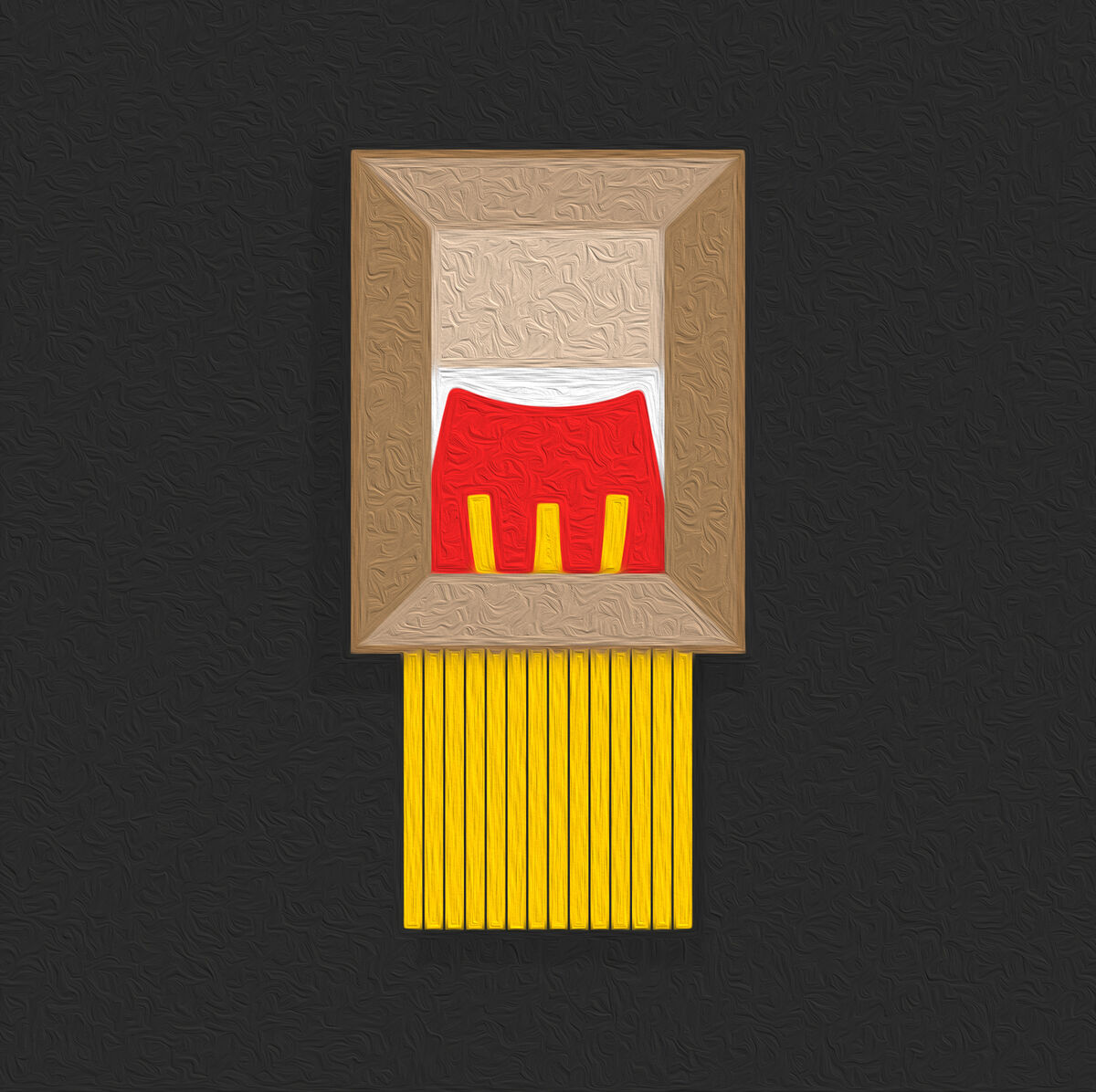
The “Framed Fries” design created by Richard Agius, Creative Director at TBWA\ANG. Courtesy Richard Agius and TBWA\ANG.
McDonald’s creative agencies, apparently unaware of where Banksy’s allegiances lie, have swiftly begun appropriating the artist’s recent auction house stunt for branding purposes. “We got Banksy’d” is how Alex Branczik, head of Contemporary Art at Sotheby’s in Europe, put it after Banksy bamboozled collectors and (reportedly) staff alike when, right after it sold Friday for $1.3 million, his painting Girl With Balloon (2006) self-destructed. Now, major brands are rushing to get Banksy’d, too.

An image by DDB Vienna combining the shredded Banksy and distinctive McDonald’s branding. Image courtesy DDB Vienna.
The image of the shredded work has been memed and is now serving as fodder for Golden Arches’ marketing. Two branding agencies served up some art of their own featuring french fries in place of the tattered image. Richard Agius, senior creative director at TBWA\ANG in Malta, posted one such picture on his Instagram, and DDB Vienna posted its own take on Facebook.
A Banksy-inspired ad for IKEA Norway explains how to make a similarly shredded work; Perrier also got in on the act, as did many other brands, co-opting Banksy’s latest viral moment to move product.
Alex Wexelman
Oct 10, 2018 at 1:18 pm, via Adweek
Banksy’s Art-Shredding Stunt Is Actually Really Good + Banksy proclaims shredded canvas is a new work dubbed “Love is in the Bin"

Opinion
Can We Just Admit That Banksy’s Art-Shredding Stunt Is Actually Really Good?
It is OK to let yourself like this confounding bit of auction theater.
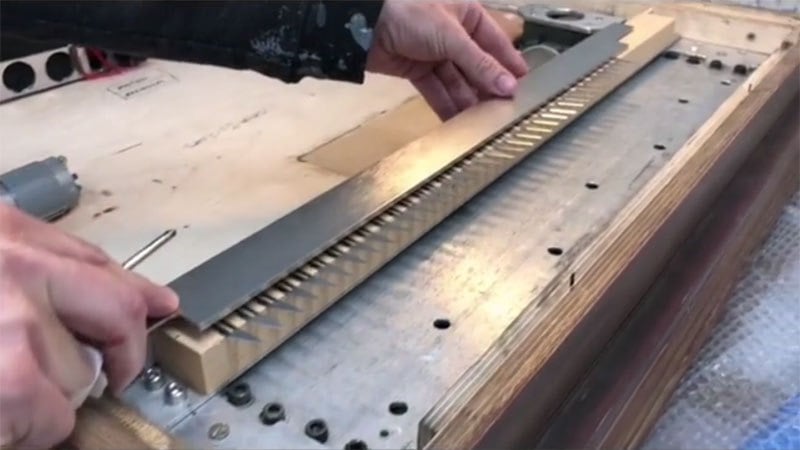
Look, I kinda like Banksy.
I know that’s not really a cool position to stake out. It is actually amazing how quickly the public reaction to what is obviously a pretty great prank—his “self-destructing” version of Girl With Balloon at last Friday’s Sotheby’s sale, moments after it sold for a record price—turned into dismissal and condemnation.
“Banksy’s prank is cynical, damaging and highly suspicious,” thundered a totally unsolicited op-ed that rolled into by email inbox on Saturday, denouncing Banksy and his suspected collusion with Sotheby’s on the prank.
“This publicity stunt is demeaning to all involved. They have treated the public and the art world with mocking contempt,” Stephen Howes of Thomas Crown Art went on to declare righteously. Such outrage!
It is truly funny for uninvolved parties sending out press releases to denounce other people for publicity seeking. (The gentleman in question runs a cryptocurrency-art business.)

Banksy’s Girl with a Balloon appeared to shred itself after selling for $1.4 million at Sotheby’s on Friday night. Courtesy of Sotheby’s.
Aside from just being a great gag, I love the variation of the Liar’s Paradox that the “self-destructing art” stunt puts Sotheby’s in.
Being in on it puts the auction house in the awkward position of having lied to any of the rich people who would have set their heart on the work (which, after all, was voted the UK’s “best-loved” piece of art) or invested time in bidding, for the sake of… PR to attract more rich people?
Even if it were to turn out that Banksy himself was actually both the seller and the final buyer, this strikes me as a dicey gambit for Sotheby’s: The kind of people who spend big bucks at auction have huge egos and do not like having their time wasted, let alone being the butt of a joke. So I don’t really get the motive, and if Banksy or his team convinced someone to do it, hats off to them.
On the other hand, having not been in on the prank makes Sotheby’s look incompetent. And the kind of denials they are offering are just what you would expect the auction house to make if they were in on it.
So there the whole thing sits, a mystery.
Banksy is certainly not my favorite artist. But give the masked artist credit for being good at what he does.
You don’t expect the emotional drama and masterful craft of Caravaggiofrom a Banksy stencil. For that matter, you also don’t expect the precisely researched institutional critique of Hans Haacke. You have to judge a work of art according to the rules of the genre of which it is a part.
Street art doesn’t trade in images for the ages or subtle ideas. Its gestures are meant to work on you quickly, be temporary, and play to the person on the street.

A graffiti titled Balloon Debate by Banksy, seen on August 6, 2005 on Israel’s security barrier in Ramallah, West Bank. Photo by Marco Di Lauro/Getty Images.
A very important concept in street art is placement. Street art fans will be very impressed by where and how a tag was placed—at improbable heights or on landmarks or just in places that are highly visible or where they aren’t supposed to be. That, as much as the image itself, is key to the criteria that govern its success, and one thing you can say about Banksy’s career trajectory is that he has pushed this sensibility in ever-new directions.
Obviously, the Sotheby’s prank has to be appreciated mainly, simply, as a great placement.
I do understand all the reasons why people are skeptical and why the art-shredding stunt seems just a little too perfect: it was the last work of the evening; it was ever so conveniently placed; Sotheby’s would or should have checked the frame; security would have caught whoever had the detonator…
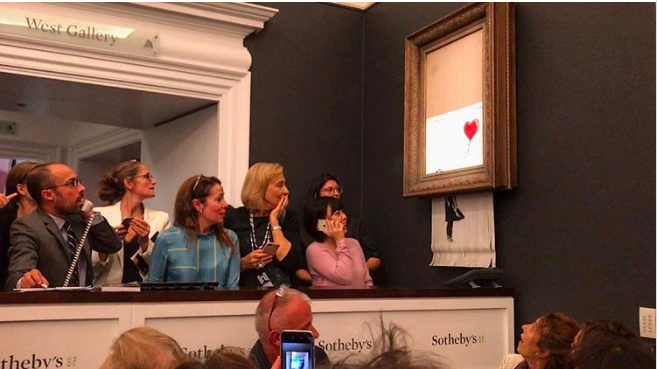
Onlookers react as Banksy’s Girl With a Balloon self-destructs at Sotheby’s.
I wouldn’t be surprised if all was not as it seemed. A staggering volume of instant analysis immediately sprung up, analyzing all the angles on the event. There are full-on Girl With Balloon Truthers out there, scrutinizing every frame and angle of the whole thing, as well as Girl With Balloon Denialists, doubting that it even happened at all.
Just what combination of backstage collusion and sleight-of-hand was necessary to maneuver the whole thing into position to happen as it did, I do not know. I’m interested to find out! As far as I am concerned, the ins and outs of how it happened are part of the fun, like watching a well-plotted heist unfold in a caper movie.
For what it is worth, I don’t personally think that it is characteristic of Banksy to do the stunt if there were nothing to it at all, i.e. if it were all totally canned and pre-arranged. I just don’t think that fits the whole MO.
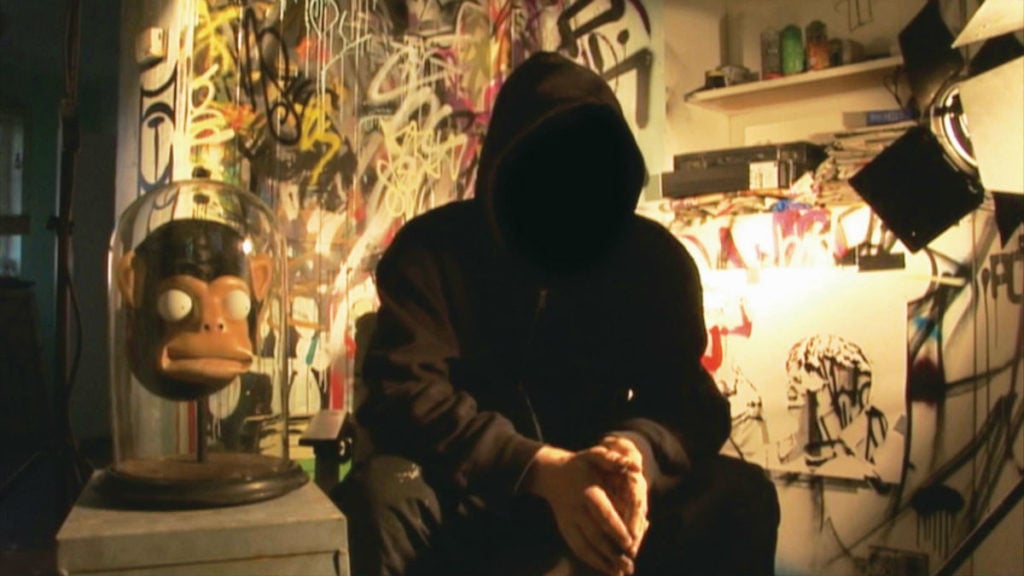
Press image from Exit Through the Gift Shop.
I’ve said this before, during the whole fracas around Exit Through the Gift Shop, his 2010 documentary.
From the time that film was first screened, people were endlessly second guessing whether its subject, Thierry Guetta, aka Mr. Brainwash, was actually a too-dumb-to-be-true Banksy concoction, asking when the whole thing was all going to be revealed as a hoax, poking holes in his biography, etc.
But here we are, eight years on, and Mr. Brainwash just keeps rolling on, doing his inane Mr. Brainwash thing, and celebrities keep buying his witless art.

ASAP Rocky and Mr. Brainwash at the 2015 Guggenheim International Gala Pre-Party made possible by Dior. Image courtesy Patrick McMullan/PMC.
The point of Exit Through the Gift Shop was not “let’s pull a fast one on the audience,” a la that same year’s Jaoquin Phoenix mockumentary I’m Still Here (remember that?), which is what critics immediately seemed to assume. The point was, “I’m going to show you this unbelievable thing”—the documentary equivalent of the feat of placing a stencil on some outrageously public place. That particular combination of self-aggrandizing cleverness and heart-on-its-sleeve bluntness is the characteristic Banksy style.
If you recall, the final moral of Exit Through the Gift Shop was that even though Mr. Brainwash was unveiled as a fraud, that hadn’t affected the hunger for his work, because fame was a self-perpetuating machine and the art market—very much including the market for street art—was fundamentally stupid.
For this reason, the second major talking point about Banksy’s “self-destructing” art—that it is somehow hypocritical or corrupt in that the shredded remains may be more valuable than ever, since they are now associated with a famous media event—also seems beside the point to me.
In this sense, this latest Banksy outrage most resembles a stunt from his 2013 unsolicited “residency” in New York, when his team set up a street stall, selling original Banksy stencils for $60 as if they were cheap knockoffs. The few people who bought them ended up with a bonanza.
In that case, nothing changed about the art, but the changed attribution completely altered how the image was valued. In the present case, the art was destroyed, but since the Banksy-ness of this Banksy only increased, its value senselessly persists. Either way, having a laugh at that absurdity of it all is the point.
Nobody likes to risk being a rube, and the media has become a hall of mirrors of fake viral stunts. The safest position to occupy is always the skeptical one.
But I mean, if the first thing you think about this stunt isn’t, “wow what a funny gag,” I just think you may be proving Banksy’s point about how art takes itself way too seriously.
Follow artnet News on Facebook:
Want to stay ahead of the art world? Subscribe to our newsletter to get the breaking news, eye-opening interviews, and incisive critical takes that drive the conversation forward.

Ben Davis
---|---

News
Oct 11
Banksy proclaims shredded canvas is a new work dubbed “Love is in the Bin.”
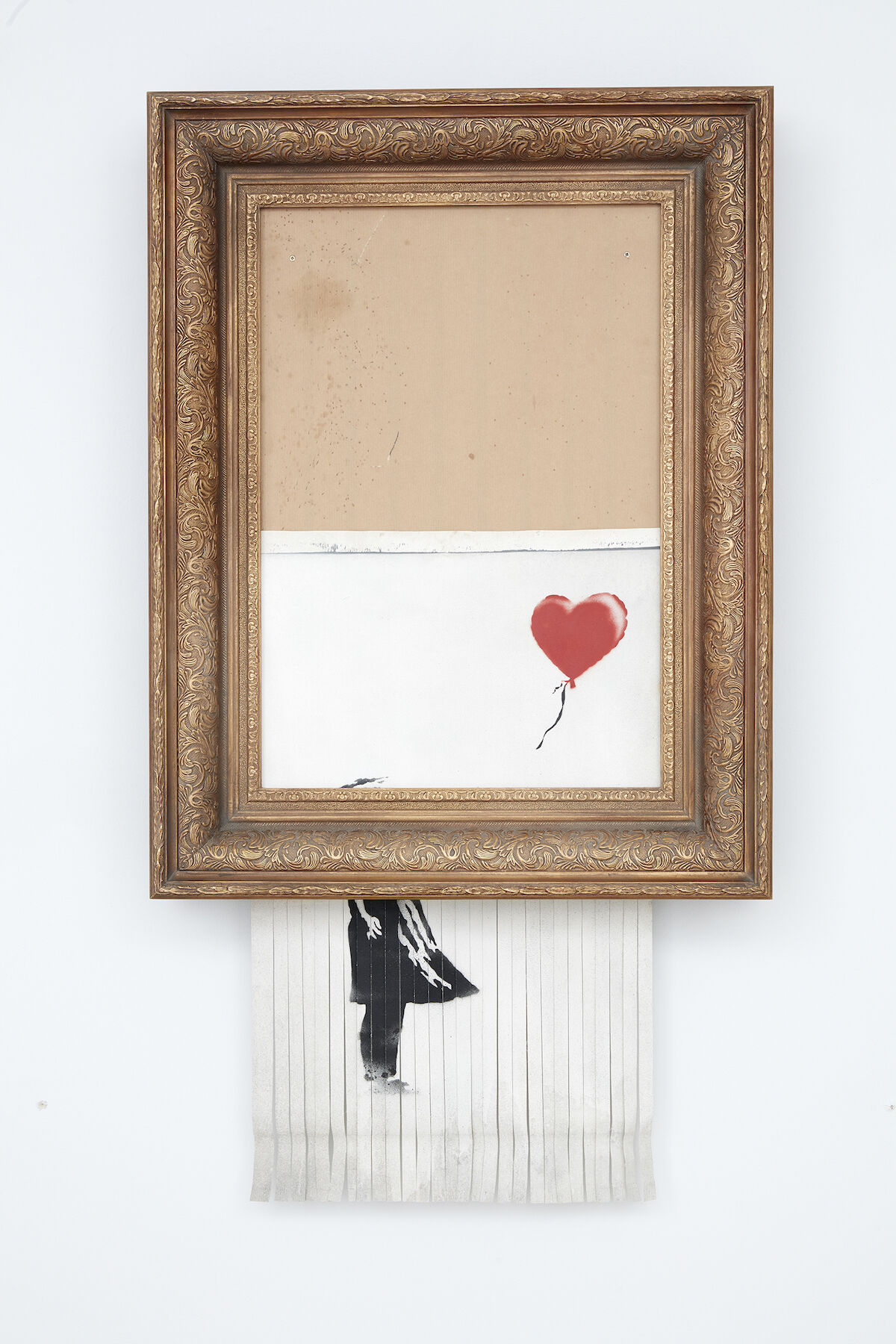 Bansky, Love is in the Bin, 2018. Sold for £1,042,000. Courtesy Sotheby’s.
Days after Banksy shocked the world by shredding his canvas Girl With Balloon (2006) immediately after it sold for $1.3 million at Sotheby’s, the artist announced that the canvas and the frame it is still stuck in now comprise a new work, called Love is in the Bin (2018). The new work has been granted a certificate by Pest Control, Banksy’s authentication body, and will be on display at Sotheby’s New Bond Street saleroom this weekend.
“Banksy didn’t destroy an artwork in the auction, he created one,” Alex Branczik, Sotheby’s Head of Contemporary Art, Europe, said in a statement. “Following his surprise intervention on the night, we are pleased to confirm the sale of the artist’s newly-titled Love is in the Bin, the first artwork in history to have been created live during an auction.”
The auction house also confirmed that the winning bidder from Friday night is proceeding with the purchase, but did not reveal the identity of the buyer, just that it is a “female European collector and a long-standing client of Sotheby’s.” In a statement, the buyer said: “When the hammer came down last week and the work was shredded, I was at first shocked, but gradually I began to realise that I would end up with my own piece of art history.”
Bansky, Love is in the Bin, 2018. Sold for £1,042,000. Courtesy Sotheby’s.
Days after Banksy shocked the world by shredding his canvas Girl With Balloon (2006) immediately after it sold for $1.3 million at Sotheby’s, the artist announced that the canvas and the frame it is still stuck in now comprise a new work, called Love is in the Bin (2018). The new work has been granted a certificate by Pest Control, Banksy’s authentication body, and will be on display at Sotheby’s New Bond Street saleroom this weekend.
“Banksy didn’t destroy an artwork in the auction, he created one,” Alex Branczik, Sotheby’s Head of Contemporary Art, Europe, said in a statement. “Following his surprise intervention on the night, we are pleased to confirm the sale of the artist’s newly-titled Love is in the Bin, the first artwork in history to have been created live during an auction.”
The auction house also confirmed that the winning bidder from Friday night is proceeding with the purchase, but did not reveal the identity of the buyer, just that it is a “female European collector and a long-standing client of Sotheby’s.” In a statement, the buyer said: “When the hammer came down last week and the work was shredded, I was at first shocked, but gradually I began to realise that I would end up with my own piece of art history.”
Banksy proclaims shredded canvas is a new work dubbed “Love is in the Bin.”

Bansky, Love is in the Bin, 2018. Sold for £1,042,000. Courtesy Sotheby’s.
Days after Banksy shocked the world by shredding his canvas Girl With Balloon (2006) immediately after it sold for $1.3 million at Sotheby’s, the artist announced that the canvas and the frame it is still stuck in now comprise a new work, called Love is in the Bin (2018). The new work has been granted a certificate by Pest Control, Banksy’s authentication body, and will be on display at Sotheby’s New Bond Street saleroom this weekend.
“Banksy didn’t destroy an artwork in the auction, he created one,” Alex Branczik, Sotheby’s Head of Contemporary Art, Europe, said in a statement. “Following his surprise intervention on the night, we are pleased to confirm the sale of the artist’s newly-titled Love is in the Bin, the first artwork in history to have been created live during an auction.”
The auction house also confirmed that the winning bidder from Friday night is proceeding with the purchase, but did not reveal the identity of the buyer, just that it is a “female European collector and a long-standing client of Sotheby’s.” In a statement, the buyer said: “When the hammer came down last week and the work was shredded, I was at first shocked, but gradually I began to realise that I would end up with my own piece of art history.”
Subscribe to:
Comments (Atom)


















